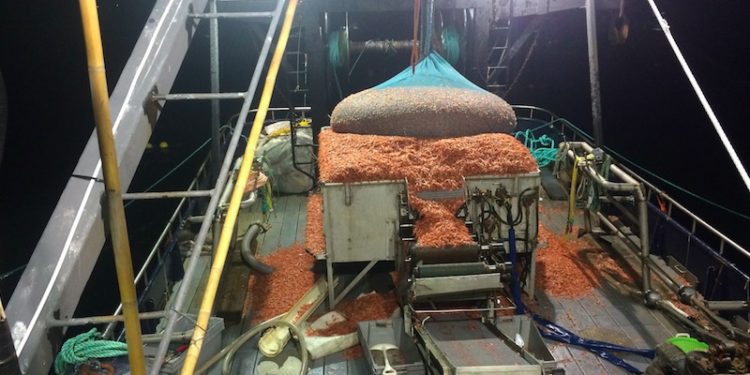A deck load of shrimp is not something you are generally prepared for. Just ask Buddy King of the 78-foot Pacific Hooker fishing from Brookings, Oregon, who has been using Wesmar’s new dual stabilised beam HD860-60kHz sonar in the shrimp fishery off the California, Oregon, and Washington coasts.
He recently pulled in both his trawl nets one after another, filling up not just his fish hold but his deck as well with shrimp.
‘Wesmar’s stabilised dual beam sonar helps keep me out of trouble. It protects my nets when going over rocks. I can locate the hard bottom where I risk ruining my nets,’ he said.
‘The Wesmar sonar gives good distinction between hard and soft bottom. Without it you can’t see. I fish the coasts of Washington, Oregon and California. I just can’t remember the whole coast, so this sonar is a great help. I use the narrow beam to look far ahead and the wide beam for a more detailed picture of the bottom.
‘Last year, without this sonar, I tore three and a half nets nets, and this year just one – and that was my fault. It was my first shrimp trip with the Wesmar and I didn’t believe what the sonar was showing,‘ he admitted.
‘Tearing nets is expensive. Not only to replace, but we lose costly time. I carry two spares with me to avoid the down time. And even with spares on board we burn up time switching them out. It easily burns up half a day. Reefs can be a big problem when fishing crab and the Wesmar is good for locating those too.’
Pacific Hooker is part of the west coast shrimp trawler fleet. Buddy King and his crew filled his boat with a big deck load of pink shrimp 18.5 miles off the coast of Washington.
‘We used the Wesmar to follow the edge between hard and soft bottom. This way we protect our nets and still harvest the fish. These fish were at 80 fathoms. I use both of the beams, the narrow one for long range and the expanded one to map the bottom in more detail. Before the Wesmar, the risk of tearing up the net kept me from navigating near a lot of places.’









